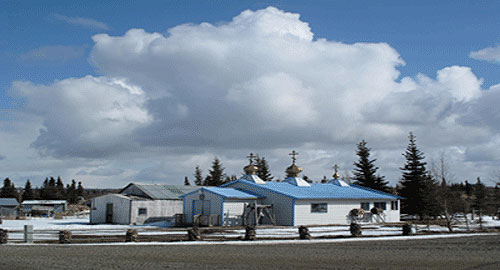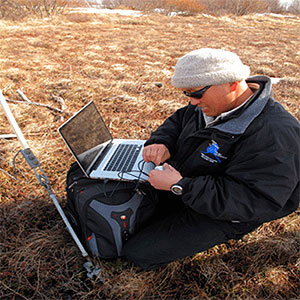 By NED ROZELL May 04, 2010
"This is a model town," he says to 14 students in the school who have gathered for the University of Alaska Fairbanks scientist's presentation. "How Koliganek changes in the future might be like how other parts of Alaska change."  Photo by Ned Rozell
While watching the movie, students shoot glances between the caped superhero on the screen and the broad-shouldered Japanese man with the shaved head who is visiting them. When the video finishes, Yoshikawa projects on the whiteboard an engineer's report from mid-1990s construction in the village. "In 1990s, they drill a lot (looking for permafrost - a relic of a colder climate long ago defined as soil or anything else that remains frozen through the heat of at least two summers)," he says. "They found permafrost."
On this late April day, Yoshikawa has downloaded data from a "permafrost observatory" he installed here behind the school one year ago. He has found temperatures above freezing beneath the ground surface, indicating that the permafrost that existed in the village in the recent past now seems to be gone. "In 20 years, huge change," he says. His presentation prompts a question from a Koliganek English teacher. "That's why my door doesn't close?" Rick Rae says. "Looks like you have something going on here," Yoshikawa says. "But things change slowly." Koliganek, located on the Nushagak River, is about the same latitude as Homer, but with a colder, farther-from-the-ocean climate. The village is right on the southern edge of where permafrost exists in Alaska. Koliganek may be one of the first places in Alaska where permafrost is degrading in a wide swath due to something other than people stripping away natural insulation or otherwise warming the ground. If so, the village is an example of what might happen in other places in Alaska if air temperatures warm. "Report from here is extremely important," Yoshikawa tells the students. "In the next years, you might notice plants changing." On the walk between town and the airstrip, Yoshikawa paused at a house, built to ground level with no air circulation beneath. The front steps had jackknifed toward the door. Yoshikawa took a photo of the steps as a man watched through his picture window. Yoshikawa made the discovery of the missing permafrost in Koliganek as part of his mission to visit as many villages as possible in Alaska. To date, he has installed ground-monitoring stations in about 170 Alaska communities. On the day he visited Koliganek, he would see seven villages before nightfall. As he lifted off from the airstrip for the 15-mile flight to New Stuyahok, where he would drill another permafrost observatory, Yoshikawa looked down on Koliganek. When the pilot banked the plane southward and spring-brown tundra filled the passenger windows, Yoshikawa wondered to himself if - when he returns in a year or two - he might see a few more shrubs or other changes to this place, one that has made a silent and so-far subtle transformation from frozen to thawed. University of Alaska Fairbanks, in cooperation with the UAF research community. Ned Rozell [nrozell@gi.alaska.edu] is a science writer at the institute. Publish A Letter in SitNews Read Letters/Opinions
|
||
